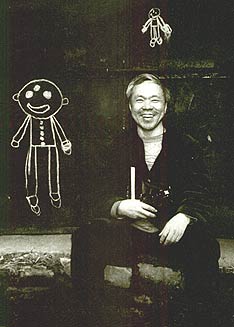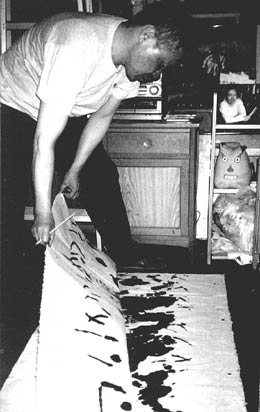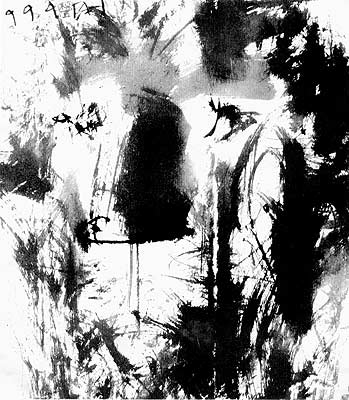BAFA © 2010. All material here is copyrighted. See conditions above. |
Yang Gang
visual artist, teacher, P.R. China
|

Yang Gang on a street corner in 1998. Photo: Liz Coats, New Zealand.
|
Notes from China
by Liz Coats, New Zealand.
Part 1: Yang Gang - ‘The Great Wide Open’
In 1998 I had the opportunity to work for four months at the Beijing Art Academy in China on an Australian Asialink-sponsored residency. The painter, Yang Gang chose to be my tutor during the residency and his studio was near mine. We had no language in common, but as time passed empathy grew between us around the work we were both separately doing.
The Beijing Art Academy was established in the 1950’s to support prominent Chinese painters in their full-time studio practice and, from the Government’s point of view, to protect and influence continuity in Chinese culture. The artists have a studio and apartment in the compound and a pension for life. While the Academy supports professional artists, scholarship students from all over China are given tuition in traditional paintings methods on a one-to-one basis.
|
During the Cultural Revolution, successful Academy artists made idealised paintings of politicians, workers and soldiers. Now many of these artists experiment with techniques and subject matter using ink, acrylic and oils. The Academy artists I met, made it plain to me that they were able to express their inner feelings through their art. On walls in their studios I noticed fresh images of naked women in swirling colours and galloping horses with exaggerated extremities. In the 1990’s, Academy artists were often perceived by the wider community of artists, particularly younger artists who have had contact with other cultures, as conservative and unresponsive to contemporary events.
My tutor, Yang Gang, was deeply affected by an experience of living and working with nomadic people in Inner Mongolia during the political upheavals of the 1970’s, when his initial painting studies were interrupted by the Cultural Revolution. The notebooks of sketches he made at that time are now a source for many of his paintings and he calls himself a ‘Grasslands’ artist. He also experiments with western influences in paintings on paper, and oils on canvas, but with his own bold independence.
|

Yang Gang working in his studio,1998.
Photo: Liz Coats, New Zealand.
|

Setting Out, ink on paper, 1999.
|
Talking about his approach he has said (in translation):I was brought up in my motherland, yet I am now a member of our modern society. I therefore see the future as a combination of the traditional and the contemporary. If everyone paints from within themselves, this will be achieved.
From: The Long and Winding Road: Paintings by Yang Gang, catalogue published by Zee Stone Gallery, Hong Kong, 1996.
While he is resistant to interference, his work speaks with an open and generous intent. He was sharply observant without being obvious, always keeping a sketchbook or camera at hand away from the studio. His directness in communication showed naturally in the sketches and during painting activity and this was a logical way for us to communicate.
Yang Gang told me that he was trying to assimilate the archaic and naturalistic rhythms of Qin, Han and Tang Dynasty painting rather than associating with the literary and technical accomplishments of Chinese literati painting, which have prospered since the Song Dynasty.
|
He wanted to achieve an ‘archaic but new’ quality of realism in his work.
Making paintings and drawings of people in everyday life, with subtle attention to character, necessitates a technical facility without loss of empathy in self-conscious embellishment. In this genre, Yang Gang did not need historical references or stylistic additions to convey what he meant, knowing that a good painting has to have internal coherence that is more than literal. At the same time, the traditional materials he used were entirely adequate. The ‘archaic’ quality showed in his observations in real time and image construction which did not preclude the rough edges and gaps that are often a result of immediate responses. His recent ink on paper paintings have impulsive and chaotic qualities that make it seem as if the fluid nature of the medium is the driving force.
I watched closely the way these combinations of brushmarks found shape. The touch of brush to paper regulated ink flow, so his movements could be slow and considered or darting and forceful. Placements were aimed at weight, leverage and energy, rather than linear description and contained an element of coincidence that was extended by the liquidity, absorbency and drying time of the medium. Working with the psychological impact of this very direct method, I watched him coaxe a unity between the connective underpinnings of experienced figuration and the immediacy (chance) that is a characteristic of ink and water-based work on paper.
One way Yang Gang avoided contrived marks was to lay two or three large sheets of paper on top of each other on the concrete floor. Bleeding through, ink marks on each layer captured a different quality and character from the threads of movement above. Often the top sheet would be thrown away, while impressions underneath were modified with direct additions to sharpen and clarify detail. In addition, I saw images on paper turned back to front and reworked to retain the suggestive marks that enlivened these impressions; always with a disciplined awareness of underlying structure.
|

Portrait of a Lion, ink on paper, 1999.
|
The ‘natural’ materials of ink, paper and brushes were considered by Yang Gang to be the most reliable and long-lasting and, while relatively uncomplicated, their effects could be extremely subtle. Outcomes were never fully under control, so that at best there was an on-going balance between uncertainty, prediction and the desire to make assertive statements.
Reflecting on the extent and subtlety of expression developed in Chinese ink painting using these simple materials, I found the link for me was in liquidity. Brushes were constructed to hold liquid in reserve, so that ink flowed with degrees of control. I watched Yang Gang hold brushes in a way that followed the angle of his arm in a firmly directed fashion. I also played ten-pin bowls with him and other artists and realised then just how well he followed through the momentum in body/arm co-ordination.
|
Because the papers were so receptive to water, the appearance of a painting changed while drying. The black ink had great tonal flexibility in dilution and it always dried lighter, so there were issues of whether to apply overlays while the first application was still wet. Even with pure water the paper darkened. With further additions of dilute ink, an image could be difficult to distinguish until the paper dried. Again, the flow of liquid from the brush had a direct effect on marks, from the precise contact of a fine and loaded brush to the rasping effects of a thick wad of hairs, scattered and drying.
Yang Gang often worked on the floor, carefully positioning a sheet of paper so that his body movements in the cramped space of the studio could follow the intended momentum of an image. I watched him make a densely-minimal and almost calligraphic painting of Mongolian herdsmen rounding up horses. I saw how intangible elements in light could be made visible in the shifting configurations of black ink and water bleeding into light-toned, absorbent paper. What you saw were images within images, coming close to natural chaos at one minute, then re-forming into composite shapes with a few more carefully placed marks. These paintings can be added to but can’t be corrected. They are tough and delicate, with a beginning, a middle and an end. Lively images that are essentialised out of complex forms need transparency, and an unbalanced brush-load could result in the whole thing ending up in the pile of crumpled paper in the corner...
|
Excerpts from, Arts Dialogue, February 2001, pages 16 - 19
|

Arts Dialogue, Dintel 20, NL 7333 MC, Apeldoorn, The Netherlands
email: bafa@bahai-library.com
|
|



